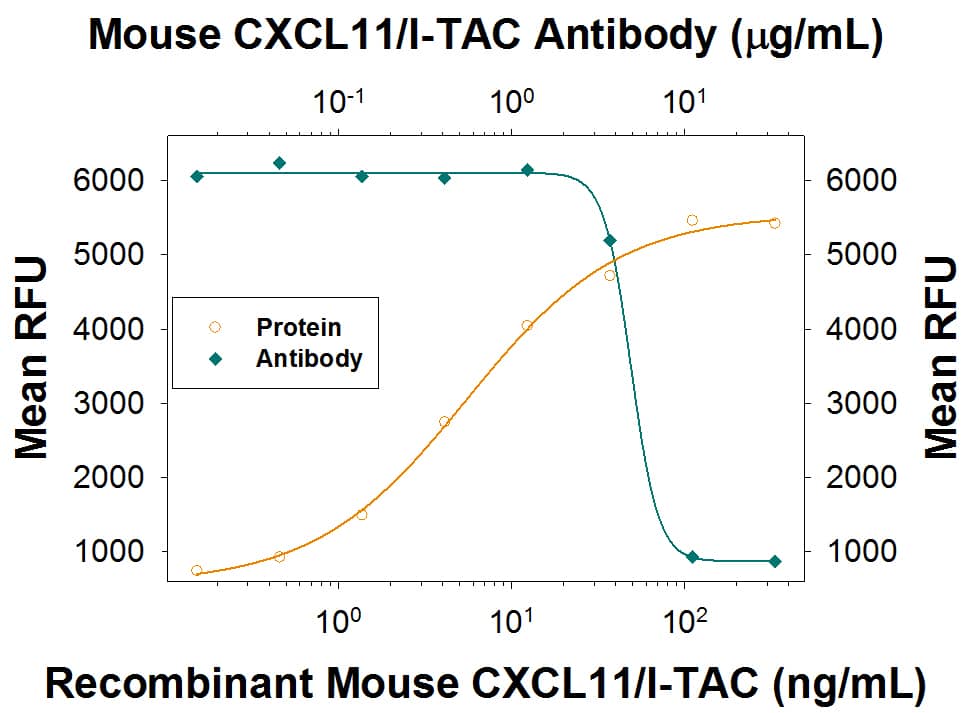Mouse CXCL11/I-TAC Antibody Summary
Phe22-Met100
Accession # Q9JHH5
Applications
Mouse CXCL11/I-TAC Sandwich Immunoassay
Please Note: Optimal dilutions should be determined by each laboratory for each application. General Protocols are available in the Technical Information section on our website.
Scientific Data
 View Larger
View Larger
Chemotaxis Induced by CXCL11/I‑TAC and Neutralization by Mouse CXCL11/I‑TAC Antibody. Recombinant Mouse CXCL11/I-TAC (Catalog # 572-MC) chemoattracts the BaF3 mouse pro-B cell line transfected with human CXCR3 in a dose-dependent manner (orange line). The amount of cells that migrated through to the lower chemotaxis chamber was measured by Resazurin (Catalog # AR002). Chemotaxis elicited by Recombinant Mouse CXCL11/ I-TAC (200 ng/mL) is neutralized (green line) by increasing concentrations of Goat Anti-Mouse CXCL11/I-TAC Antigen Affinity-purified Polyclonal Antibody (Catalog # AF572). The ND50 is typically 2-12 µg/mL.
Preparation and Storage
- 12 months from date of receipt, -20 to -70 °C as supplied.
- 1 month, 2 to 8 °C under sterile conditions after reconstitution.
- 6 months, -20 to -70 °C under sterile conditions after reconstitution.
Background: CXCL11/I-TAC
CXCL11 (also known as I-TAC, SCYB9B, H174, IP-9, and beta -R1) is a member within the non-ELR CXC chemokine subgroup and has been designated CXCL11. CXCL11, together with MIG and IP-10, constitute a subset of chemokines that are ligands for CXCR3, a chemokine receptor that is primarily expressed on activated Th1 cells and NK cells. The three chemokines were also reported to act as antagonists for CCR3, a chemokine receptor that is preferentially expressed on activated Th2 cells. Mouse CXCL11 cDNA encodes a 100 amino acid (aa) residue precursor protein with a putative 21 aa residue signal peptide that is cleaved to yield a 79 aa residue mature protein. Mature mouse and human CXCL11 share 71% aa sequence identity. Mouse CXCL11 also shares 36% and 29% aa sequence identity with mouse IP-10 (CRG-2) and mouse MIG, respectively. The gene for mouse CXCL11 has been mapped to chromosome 5, in close proximity to the IP-10 and MIG genes. Mouse CXCL11 is induced in multiple tissues during endoxemia, with the greatest expression in lung, heart, small intestine, and kidney. The endotoxemia-induced mouse CXCL11 expression is strongly attenuated by treatment with glucocorticoid.
- Widney, D.P. et al. (2000) J. Immunol. 164:6322.
- Meyer, M. et al. (2000) Cytogenet. Cell Genet. 88:278.
- Loetscher, P. et al. (2001) J. Biol. Chem. Manuscript M005652200.
Product Datasheets
Citations for Mouse CXCL11/I-TAC Antibody
R&D Systems personnel manually curate a database that contains references using R&D Systems products. The data collected includes not only links to publications in PubMed, but also provides information about sample types, species, and experimental conditions.
5
Citations: Showing 1 - 5
Filter your results:
Filter by:
-
Identification of CXCL11 as part of chemokine network controlling skeletal muscle development
Authors: Malte Puchert, Christian Koch, Konstanze Zieger, Jürgen Engele
Cell and Tissue Research
-
CXCR7 Antagonism Reduces Acute Lung Injury Pathogenesis
Authors: L Pouzol, A Sassi, N Baumlin, M Tunis, DS Strasser, F Lehembre, MM Martinic
Oncogene, 2021-11-05;12(0):748740.
Species: Mouse
Sample Types: Plasma
Applications: ELISA Detection -
Complementary Activity of ETV5, RBPJ, and TCF3 Drives Formative Transition from Naive Pluripotency
Authors: T Kalkan, S Bornelöv, C Mulas, E Diamanti, T Lohoff, M Ralser, S Middelkamp, P Lombard, J Nichols, A Smith
Cell Stem Cell, 2019-04-25;0(0):.
Species: Mouse
Sample Types: Whole Cells
Applications: ICC -
Sensing and alarm function of resident memory CD8(+) T cells.
Authors: Schenkel J, Fraser K, Vezys V, Masopust D
Nat Immunol, 2013-03-31;14(5):509-13.
Species: Mouse
Sample Types: Whole Tissue
Applications: IHC -
Comprehensive assessment of chemokine expression profiles by flow cytometry.
Authors: Eberlein J, Nguyen TT, Victorino F, Golden-Mason L, Rosen HR, Homann D
J. Clin. Invest., 2010-02-08;120(3):907-23.
Species: Mouse
Sample Types: Whole Cells
Applications: Flow Cytometry
FAQs
No product specific FAQs exist for this product, however you may
View all Antibody FAQsReviews for Mouse CXCL11/I-TAC Antibody
There are currently no reviews for this product. Be the first to review Mouse CXCL11/I-TAC Antibody and earn rewards!
Have you used Mouse CXCL11/I-TAC Antibody?
Submit a review and receive an Amazon gift card.
$25/€18/£15/$25CAN/¥75 Yuan/¥2500 Yen for a review with an image
$10/€7/£6/$10 CAD/¥70 Yuan/¥1110 Yen for a review without an image

